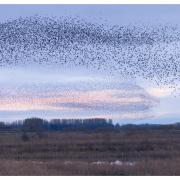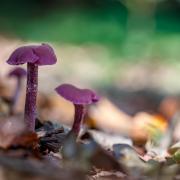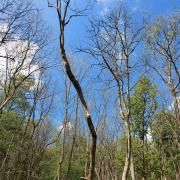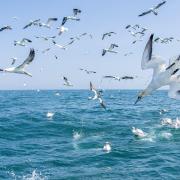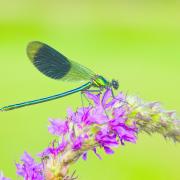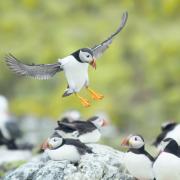Six hero species are leading the way in Yorkshire Wildlife Trust’s Great Yorkshire Creature Count, writes Hetti Lawrence from the organisation. What does this tell us about the future of the county’s wildlife?

Yorkshire Wildlife Trust undertook its first ever Great Yorkshire Creature Count, a wonderful 24 hours spent in search of the wildlife on our doorsteps. For one weekend only, we asked the people of Yorkshire to explore their outdoor spaces and spot, snap and record the wildlife found there. We had an incredible response with more than 13,000 observations recorded over the 24 hours, and more than 1,400 different species.
We may still be collating the results but taking part in the Great Yorkshire Creature Count served as a wonderful reminder of the myriad of incredible wildlife many of us are lucky enough to live alongside. In true celebration of Yorkshire, we will be releasing the full results on Yorkshire Day on our website – with more details on them in the next issue of Yorkshire Life. But we wanted to introduce you, before then, to our six hero species.
Helping guide the people of Yorkshire around their outdoor spaces, the Great Yorkshire Creature Count’s hero species are the perfect introduction to the variety of animals found in every corner of our gardens, yards and window boxes – from lurking in the depths of lush ponds to wheeling through the air at dusk on a summer’s evening.

Pipistrelle bat
Is it a bird, is it a plane? No, it’s a pipistrelle bat! Zooming just above your head this furry, flying wonder can fit inside a match box and weighs as little as a 20p piece. As the warm summer sunlight fades, you might mistake these special creatures for birds heading to roost as they frantically flap through the dusk sky, but they’re just starting their ‘day’. Fast fliers with incredible aerial agility, they swoop and dive to catch up to 3,000 insects each night.

Small tortoiseshell butterfly
Imagine a warm summer’s day, walking by a meadow or in the park, around you flits of colour parade themselves; butterflies are following their summer ritual pollinating and feeding on flowers and using their shocking colours to ward off predators. An orange and black beauty hovers for a few seconds showing its striking patterns to the world. A real nomad, able to live anywhere from mountain top to valley bottom, this butterfly can be found almost everywhere in Britain. Striking orange and black wings adorned with crystal gems make the small tortoiseshell butterfly easily recognisable.
Swifts
Silhouetted high in the sky, swifts are easy to recognise from their iconic arched wing shape and short forked tail. Each spring they travel from south of the Sahara, surveying much of Europe along the way. Their arrival heralds the start of summer. Swifts are hard to forget, soaring amongst the chimney stacks and skyscrapers, screeching to one another and then suddenly swooping into their nests hidden amongst the eaves and barn beams. Swifts have unbelievable stamina: they very rarely land, earning them their Latin name meaning ‘no-foot no-foot’. They fly for months at a time, eating, sleeping and mating without ever landing. But once here and ready to lay their eggs and raise their chicks they seek the same sheltered, secluded space each year.
Hedgehogs
Voted Britain’s most loved mammal, the hedgehog is a night-time visitor that gardeners adore. This little carnivorous creature uses smell and sound to hunt down its prey of worms, beetles, slugs and snails as it meanders through our neighbourhoods under the cover of darkness. Hedgehogs have poor eyesight and so rely on landmarks such as hedgerows and garden edges to find their way around.
Common frog
Childhood memories are filled with gelatinous frogspawn that magically transforms into wriggling black dots and then, too soon, becomes shiny green frogs hopping away into secret, damp hideaways. But look closer and you‘ll see each tadpole speckled with gold, setting them apart from their more drab toad cousins. Even adult common frogs are smarter than their olive green exterior appears with the ability to change their colour (in a limited way) to match their surroundings.
Garden bumblebee
A fuzzy little body and yellow and black stripes adorned with a white tail? It’s most likely to be our garden bumblebee. With their stripes they bring a comforting buzz and nostalgic sense of summer. Close your eyes and imagine a bumblebee – you can’t picture them without a fantastic flower to buzz around and neither can they! A summer’s day wouldn’t be right without their lazy buzz as they bob and weave from flower to flower collecting pollen and nectar.
What’s next for our heroes?
Common frog, garden bumblebee, hedgehog… at first glance, our heroes all appear as familiar and commonplace wildlife; but we know that, sadly, that is not the case. Though we have yet to collate the full results of the Great Yorkshire Creature Count, we know much of our beloved garden wildlife has suffered terrible decreases in numbers over the last 50 years.
We hope the Great Yorkshire Creature Count served as a joyful reminder of the buzzing, singing, snuffling life that lives, feeds and breeds in our gardens. But we also hope that it inspired you to create bigger, better space for wildlife at your home – particularly if your results were lower than you hoped. While we wait for the full results next month, why not spend this time making a hedgehog highway, putting in a pond (even a mini one would do), planting some wildflowers or installing a swift box? We want to create a wilder future for Yorkshire’s wildlife, but we can’t do that without you! To find out more about how you can help wildlife in Yorkshire, go to ywt.org.uk/wildlife-recovery-fund












